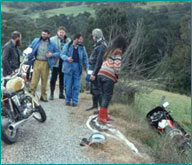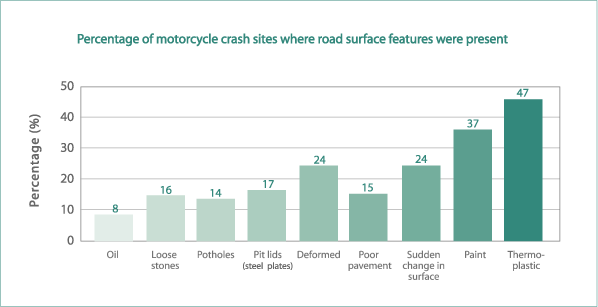Single Vehicle Crashes
 Motorcycles are far more likely to be involved in a single vehicle crash than are cars. In NSW, single vehicle crashes accounted for 40% of all motorcycle crashes between 2001-2005 compared to 23% of car crashes.
Motorcycles are far more likely to be involved in a single vehicle crash than are cars. In NSW, single vehicle crashes accounted for 40% of all motorcycle crashes between 2001-2005 compared to 23% of car crashes.
If a driver or rider loses control of their vehicle by skidding or going off the outside of a curve it is assumed that they were going too fast for conditions. This may be a reasonable assumption for cars, which are less vulnerable to sudden changes in the road surface, but should not always be assumed for motorcycles.
Excessive speed and rider error may well be factors, but there is also substantial evidence that road surface conditions contribute to at least one in five single vehicle motorcycle crashes.
Crash research
Analysis of single vehicle crashes in NSW (2001-2005) found that road surface hazards were a contributing factor for:
- 21% of motorcycle crashes compared to only 6% of car crashes
- 27% of motorcycle crashes on curves
- 14% of fatal motorcycle crashes on curves. (Positioned for Safety 2010).
In the 2006 MCC survey of riders in NSW, loss of traction due to road surface condition was a factor in 43% of single vehicle crashes (de Rome & Brandon, 2007).
A Victorian study of motorcycle crashes found that road surface features likely to impair traction were present at 53% of crash sites and directly contributed to 15% of the crashes. The figure below shows the proportion of crash sites at which specific road surface features were detected (Haworth, 1999).

In NSW general duties police are not trained to recognize or understand the dynamics involved in a motorcycle crash. Police attending a crash may assume speed was a factor because they do not realize that, even at low speeds, a sudden change in the road surface can cause a motorcycle to skid and fall over.
It is important for riders to make sure such factors are recorded by police in the crash report. The questions that need to be asked are:
- What were the road surface conditions or features?
- Was there a sudden change in the road surface?
- Should the rider/ driver have been able to anticipate that change?

